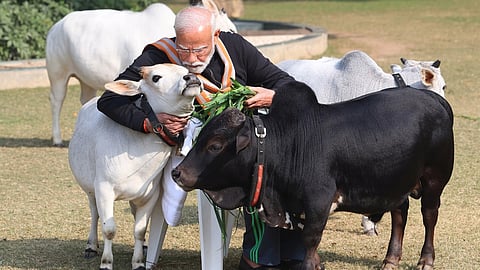

On the joyous occasion of Pongal and Makar Sankranti, Prime Minister Narendra Modi added a touch of tradition by feeding six Punganur cows at his residence on Lok Kalyan Marg. The heartwarming images of PM Modi engaging with these native cows garnered attention and sparked curiosity about the significance of the Punganur breed.
The Punganur cows, native to Andhra Pradesh and known locally as 'Punganur Kuttai,' hold a special place in India's rich cultural and agricultural heritage. Standing between 70 to 90 cm tall and weighing up to 200 kg, these diminutive creatures have small horns and long, slender tails, making them a picturesque addition to the landscape.
Ramamohan, a resident of Madanapalli in Chittoor district, sheds light on the history of the Punganur breed. "There are more than 40 breeds of Indian cattle. Four of them are of the dwarf variety. Vechur and Kasaragod dwarf cows in Kerala are like Malanad in Karnataka. These Punganur breeds are also short, only 3 or 4 feet tall. The Zamindar of Punganur in Chittoor district popularized this variety, and it got the name 'Punganur Kuttai.'"
Known for their gentle temperament, Punganur cows are not inclined to leaping, making them easy to care for without fear. Traditionally used for plowing, their bulls have been an integral part of agriculture. However, in contemporary times, these cows are primarily reared for milk, known for its low-fat content and high protein.
"Normally, green grass, corn plates, straw, and bran mixed with water are given as fodder. Since these cows are not in the habit of leaping, they can be cared for without fear. We can get 2 to 3 liters of milk per day, about 6 liters a day. Even in times of drought, they can manage with the available fodder," explains Ramamohan.
The Punganur breed faced a decline in numbers over the years, prompting the Andhra Pradesh government to allocate funds in 2020 for their conservation under the initiative 'Mission Punganur.' In the 20th livestock census, 13,275 Punganur cattle were reported in India in 2012. However, this number plummeted to 2,772 cows in 2013.
Farmers emphasize the economic value of Punganur cows, with their prices ranging from Rs 1 lakh to Rs 10 lakh based on age and appearance. The reverence for native cattle extends beyond economic considerations, as these breeds are regarded as a 'gold mine' due to their multifaceted contributions in milk production, plowing fields, and providing dung for agricultural use.
While Punganur cattle share the spotlight, they are part of a larger initiative by the central government to focus on the development and conservation of indigenous cattle breeds in India. The diverse range of native breeds, including Gir, Sahiwal, Bargur, Ongole, and Kangayam, plays a crucial role in preserving India's unique cultural and agricultural identity.
As PM Modi celebrated Pongal with these Punganur cows, the event became a symbolic representation of the efforts to uphold India's native cattle heritage. The images of the Prime Minister engaging with these gentle creatures not only showcase the cultural richness of the festival but also highlight the ongoing initiatives to conserve and promote indigenous cattle breeds across the country.